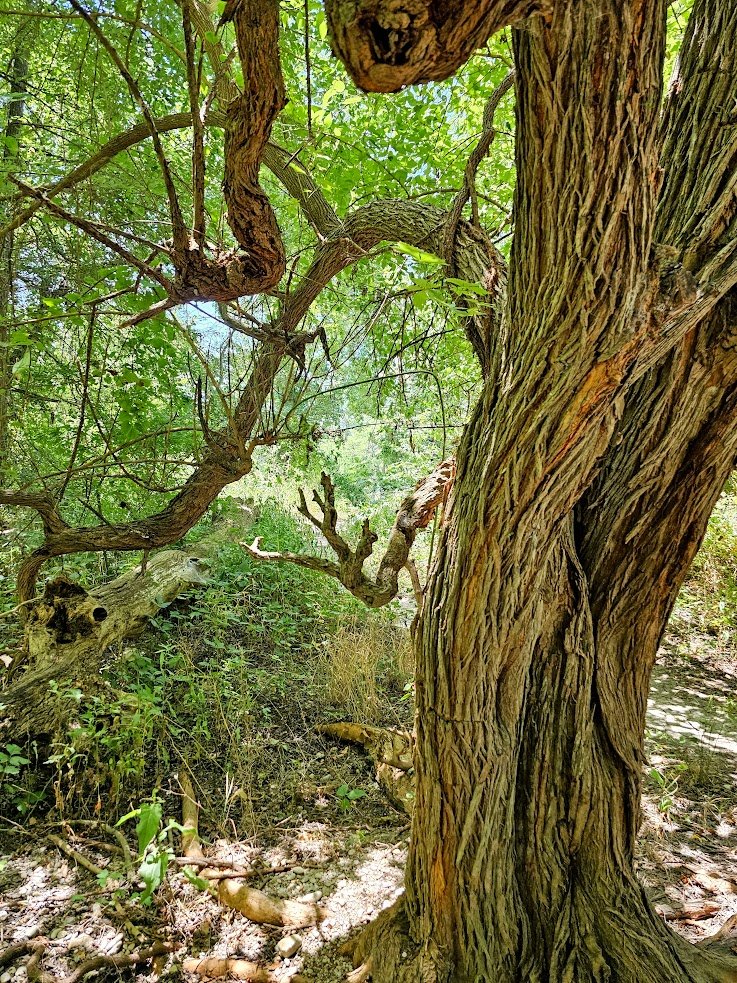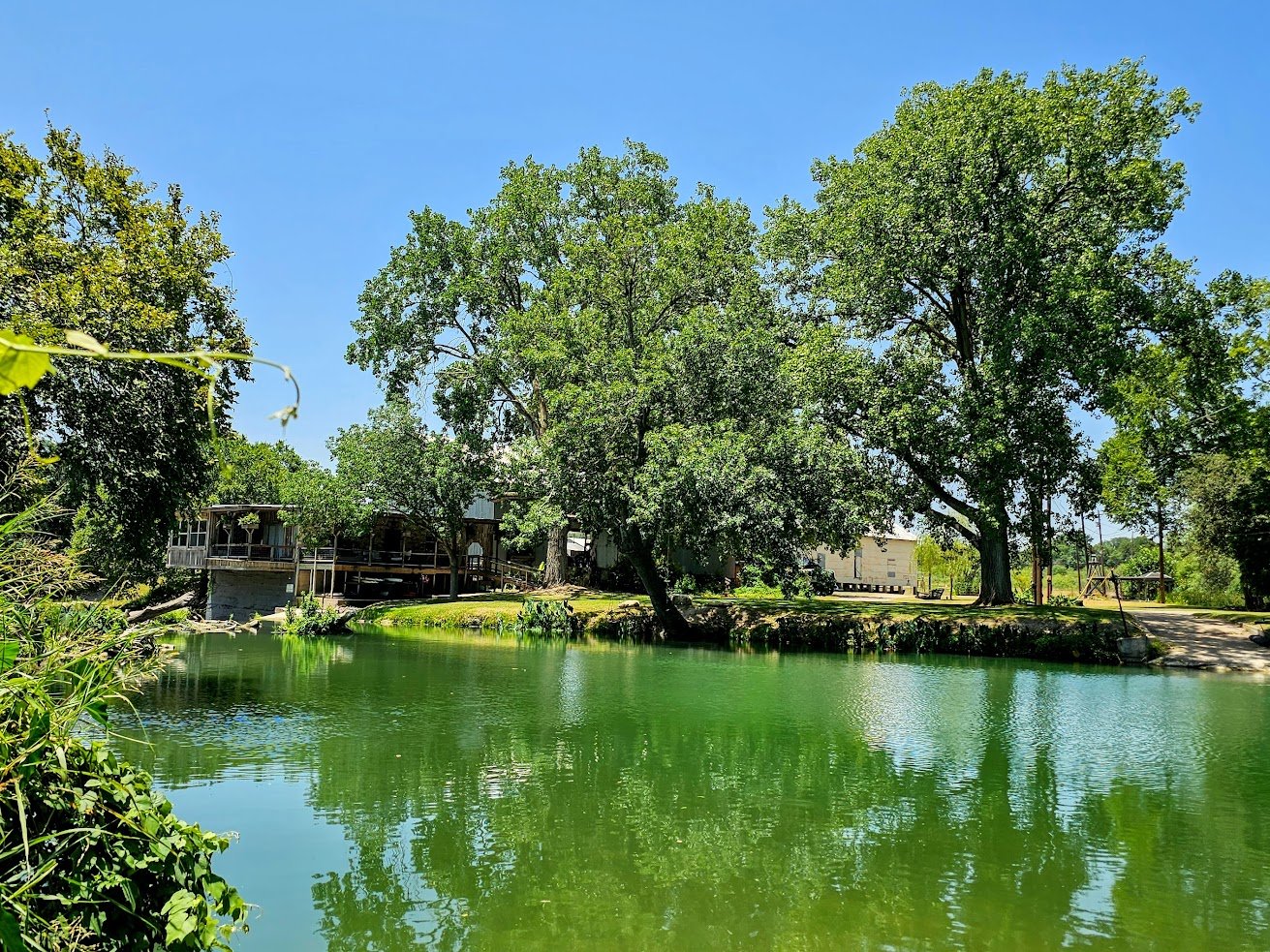The Bois d’Arc Tree
Photos are by Mike Davis and Mimi Cavender unless otherwise indicated.
Mike Davis
A couple stopped me recently on my daily walk and inquired about a particular tree they were observing. The distinctive lime green grapefruit-sized “fruit” prompted their attention and curiosity. I replied, “That’s a Bois d’Arc tree. Indians used the wood from that tree to make bows.” My reply echoed what my father had taught me about the tree—that the wood was extremely hard, the fruit was inedible, and—the name is French for “bow wood”—Indians made their bows from it. As childhood memories were flooding back, I resolved to learn more.
Boys in my neighborhood called these trees “Bodark,” and of course the hard, heavy, green fruit became projectiles to throw. Spikey Flynn was on the receiving end of an accurately thrown Bodark “apple.” It hit him squarely in the forehead. He collapsed to the ground, semi-conscious, with a large ugly bruise rising from the point of impact. Luckily, he was fine, but that ended the Bodark Wars.
Maclura pomifera is a native Texas tree with many common names, including Bois d’Arc, Osage Orange, Hedge Apple, Horse Apple, and Yellowwood. It’s maligned as a nuisance—even while having books and festivals in its honor—since it’s full of thorns and its fallen fruit can be a stinky sticky mess for property owners.
As a mature tree, it can reach an elegant 40 feet tall, with eye-catching ropey bark and that weird fruit. Under the bark, its bright yellow wood is as hard and dense as ceramic—highly prized by wood craftspeople.
Bois d’Arc is not a tree you are likely to plant in your small suburban landscape. However, it has a history and characteristics that make it unique among our native Texas plant species. It was often planted to serve as an impenetrable hedge or to delineate our forefathers’ pastures.
History
The tree is thought to have originated during the Oligocene epoch, approximately 30 million years ago. Maclura pomifera and possibly 6 other Maclura species, all in the Mulberry family, spread widely across North America. It is believed that the tree and its cousins were distributed with the help of various large herbivores, such as now extinct Giant Ground Sloths, Mastodons, and Mammoths.
Fast forward to the end of the last ice age, about 12,000 years ago, when those large herbivores may have been exterminated by early Native Americans. Without the seed dispersal of the herbivores, all the Maclura species except pomifera went extinct. By the time of the European exploration of the continent, M. pomifera’s primary range had shrunk to an area encompassing the Blackland Prairies and Post Oak Savannas of Texas, Oklahoma, Arkansas, and Louisiana.
A main reason the Bois d’Arc continued to flourish in North America is that Native Americans ensured its survival due to their prolific utilization of the wood. Its utility in making bows and other objects made it an ideal trade good among tribes.
Early Europeans witnessed the Native Americans’ use of the tree and deployed it for a variety of purposes. Early settlers to Texas set up thriving businesses in the distribution of the Bois d’Arc seeds for farmers across the nation to construct thick hedgerows and fencing for livestock pens. A common saying was the Bois d’Arc hedges were “horse high, hog tight, and bull strong.” Proliferation was speedy, and by 1869 over 60,000 miles of Bois d’Arc hedges had been planted in the East, Midwest, and South. Some scholars even consider the Maclura pomifera to be as crucial as the railroad, steel plow, and windmill for the European settlement of North America.
This row of old Bois d’Arc trees is a remnant of a Texas settler’s fenceline. Photo unattributed in Texas Homesteader
The introduction of barbed wire in the 1880s began the decline of the tree’s use in hedges and fence posts—a pity, since the wood is extremely rot-resistant when in contact with the ground, thus a traditional use of Bois d’Arc piers for house foundations. The Dust Bowl brought it back to the forefront as part of President Franklin D. Roosevelt’s Works Progress Administration’s “Great Plains Shelterbelt” Project. That Depression era program, initiated in 1934, planted over 200 million trees on farmland to serve as windbreaks to prevent soil loss. Many of those mature old trees still stand; look for them in telltale rows in the landscape.
Wood
The wood is extremely hard, rated at 2,620 pounds on the Janka Hardness scale, making it one of the hardest native North American woods. Native Americans used the wood for archery bows because it has the highest work to maximum load value of any wood, giving it a rare combination of strength and flexibility. European settlers in Texas used it for wagon spokes and singletrees, axe handles, stools, and turned bowls.
Under that hard ropey bark is the ceramic-like lemon-yellow wood that dulls the woodworker’s blade.
These are Bodark wood bowls turned by Central Texas wood artisans. They are nearly impermeable.
Aesthetically, Bois d’Arc wood is a dramatic bright yellow, turning dark yellow to brown upon exposure to the air. Many craftspeople utilize the yellow wood shavings as a dye for natural fibers.
Fruit
The light green bumpy fruit, about 4–5 inches in diameter, is an aggregate of many small seeds. They are the largest fruit of any tree native to the United States. Unlike most fruits, which primarily ripen on the tree, Bois d’Arc apples often fall well before they fully ripen. The falling fruit can dent roofs—and heads! Just ask Spikey Flynn. The sticky overripe apple is inedible for humans and has an unpleasant odor—perhaps why very few native animals eat the fruit, one exception being squirrels, who only eat the seeds. Large introduced species, such as horses, will eat the Horse Apple without harm.
Bodark apple and tree alike ooze a sticky white sap. Photo unattributed in an article by Richard Pallardy in Earth.com September 19 2018
Field Trip!
Mimi Cavender
Take a short drive, just south of Hays County, along the San Marcos River at the tiny town of Staples, Texas. There’s a popular river paddling takeout spot across from private property. This lush riparian environment, with its clayey stream banks and boggy side creeks, is thick with bald cypress, native pecan, and some great examples of Bois d’Arc trees, young and old, elegant and wild.
Long ago, a landowner here pruned those native Bois d’Arc into elegant yard trees.
A mixed grove of huge old pecans and Bois d’Arc shades a high gravel bar, now a parking area.
Wild Bodarks under the shade of older pecans spread angular thorny branches but eventually find an opening to surpass the pecans in height.
The 2015 Memorial Day flood roared down the San Marcos, but this fallen Bois d’Arc clings to life.
A posted path leads through a thicket of sprawling wild Bois d’Arc. We saw no fruit in July.
Bodark trunks are multiple and fused at the base. Roots ramble out on the surface like Bald Cypress’.
Leaves are spade shaped and form linear clusters along upward-reaching branches in the canopy.
From a distance identify them among pecans by their canopy and from below by their ropey bark.
For Native Americans and early European settlers, 20th-century ranchers, and all manner of people today, Bois d’Arc trees have been fascinating, beautiful, and useful. Look for them, the gangly young ones and the old and venerable, in our Texas landscapes.













